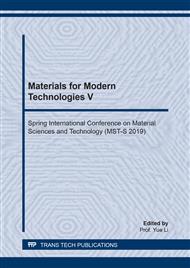[1]
H. Zhang, Y. Liu, T. Wang, Y. Yang, S.J. Shi, G. Yang, Li2ZrO3-coated Li4Ti5O12with nanoscale interface for high performance lithium-ion batteries. Appl. Surf.Sci. 368(2016) 56-62.
DOI: 10.1016/j.apsusc.2016.01.244
Google Scholar
[2]
G.Y. Liu, H.Y. Wang, G.Q. Liu, Z.Z. Yang, B. Jin, Q.C. Jiang, Synthesis andelectrochemical performance of high-rate dual-phase Li4Ti5O12–TiO2nanocrystallinesfor Li-ion batteries, Electrochim. Acta. 87 (2013) 218-223.
DOI: 10.1016/j.electacta.2012.09.010
Google Scholar
[3]
T.F. Yi, Y. Xie, Q.J. Wu, H.P. Liu, L.J. Jiang, M.F. Ye, R.S. Zhu, High rate cycling performance of lanthanum-modified Li4Ti5O12 anode materials for lithium-ionbatteries. J. Power Sources. 214 (2012) 220-226.
DOI: 10.1016/j.jpowsour.2012.04.101
Google Scholar
[4]
W. Wang, B. Jiang, W.Y. Xiong, Z. Wang, S.Q. Jiao, A nanoparticle Mg-dopedLi4Ti5O12 for high rate lithium-ion batteries.Electrochim. Acta. 114 (2013) 198-204.
DOI: 10.1016/j.electacta.2013.10.035
Google Scholar
[5]
Q.Y. Zhang, C.L. Zhang, B. Li, S.F. Kang, X. Li and Y.G. Wang, Preparationand electrochemical properties of Ca-doped Li4Ti5O12 as anode materials inlithium-ion battery.Electrochim. Acta 98 (2013) 146-152.
DOI: 10.1016/j.electacta.2013.03.006
Google Scholar
[6]
W. Li, M.Z. Chen, J.J. Jiang, R. Wu, F. Wang, W.J. Liu, G.C. Peng, M.Z. Qu, Structural and electrochemical characteristic of SiO2 modified Li4Ti5O12 as anode for lithium-ion batteries. J. Alloys Comp. 637 (2015) 476-482.
DOI: 10.1016/j.jallcom.2015.03.049
Google Scholar
[7]
X. Li, M. Qu, Z. Yu. Structural and electrochemical performances of Li4Ti5− xZrxO12, as anode material for lithium-ion batteries. J. Alloys compd. 487(2009) L12-L17.
DOI: 10.1016/j.jallcom.2009.07.176
Google Scholar
[8]
I. Seo, C R. Lee, J K. Kim, Zr doping effect with low-cost solid-state reaction method to synthesize submicron Li4Ti5O12 anode material. J. Phys &Chemi Solids. 108 (2017) 25-29.
DOI: 10.1016/j.jpcs.2017.04.011
Google Scholar
[9]
S Huang, Z Wen, J Zhang, et al. Li4Ti5O12/Ag composite as electrodematerials for lithium-ionbattery[J]. Solid State Ionics, 2006, 177:851–855.
DOI: 10.1016/j.ssi.2006.01.050
Google Scholar
[10]
H L Zhao, Y Li, Z M Zhu. Structural and electrochemical characteristics of Li4-xAlxTi5O12 as anodematerial for lithium-ion batteries. Electrochim. Acta. 53(2008) 7079-7083.
DOI: 10.1016/j.electacta.2008.05.038
Google Scholar
[11]
A. D Robertson,L Tervion, H Tukamoto. New inorganic spinel oxide for use as negative electrode materials in future lithium-ion batteries. J Power Sources. 125(2004) 242-245.
DOI: 10.1016/s0378-7753(98)00217-1
Google Scholar
[12]
X. Xia, J. Zhan, Y. Zhong, X. Wang, J. Tu, &H. J. Fan, Single‐ crystalline, metallic TiC nanowires for highly robust and wide‐ temperature electrochemical energy storage. Small. 13 (2017) 6810-6829.
DOI: 10.1002/smll.201602742
Google Scholar
[13]
M H Alfaruqi, S Islam, J Song. Carbon-coated rhombohedral Li2NaV2(PO4)3nanoflake cathode for Li-ion battery with excellent cycleability and rate capability.Chemi. Phys. Lett. 681(2017)44-49.
DOI: 10.1016/j.cplett.2017.05.047
Google Scholar
[14]
H.Ge, T. Hao, H.Osgood. Advanced mesoporous spinel Li4Ti5O12/RGOcomposites with increased surface lithium storage capability for high-powerlithium-ion batteries. ACS Appl Mater Interfaces. 8 (2016) 9162-9169.
DOI: 10.1021/acsami.6b01644
Google Scholar
[15]
X. Sun, P V. Radovanovic, B. Cui,Advances in spinel Li4Ti5O12 anode materials for lithium-ion batteries. New J Chemi. 39 (2015) B641-B644.
Google Scholar
[16]
K. Ding, J. Zhao, Y. Sun, et al. Using potassium ferricyanide as a dopant to prepare K and Fe co-doped Li4Ti5O12. Ceram. Inter. 42 (2016) 19187-19194.
DOI: 10.1016/j.ceramint.2016.09.082
Google Scholar
[17]
Y. Ma, B. Ding, G. Ji, et al. Carbon-encapsulated F-doped Li4Ti5O12 as a high rateanode material for Li+ batteries. ACS Nano. 7(2013) 10870-10882.
Google Scholar
[18]
S. Mao, X. Huang, J. Chang, et al. One-step, continuous synthesis of a sphericalLi4Ti5O12 |[sol]| graphene composite as an ultra-long cycle life lithium-ion batteryanode. Universidad De Las Palmas De Gran Canaria. 7 (2015) e224-e235.
DOI: 10.1038/am.2015.120
Google Scholar
[19]
Y. Tang, Y. Zhang, X. Rui, et al. Conductive Inks Based on a Lithium TitanateNanotube Gel for High-Rate Lithium-Ion Batteries with CustomizedConfiguration. Adv. Mater. 28 (2016) 1567-1576.
DOI: 10.1002/adma.201505161
Google Scholar
[20]
Z. Zhang, X. Deng, J. Sunarso, et al. Two‐ Step Fabrication of Li4Ti5O12‐CoatedCarbon Nanofibers as a Flexible Film Electrode for High‐ Power Lithium‐ IonBatteries. Chemelectrochem. 4 (2017) 2286-2292.
DOI: 10.1002/celc.201700351
Google Scholar
[21]
C. Masarapu, V. Subramanian, H.W. Zhu, B.Q. Wei, Long-Cycle Electrochemical Behavior of Multiwall Carbon Nanotubes Synthesized on Stainless Steel in Li Ion Batteries, Adv.Func. Mater. 19 (2009) 1008-1014.
DOI: 10.1002/adfm.200801242
Google Scholar
[22]
P. Verma, P. Maire, P. Novák, A review of the features and analyses of the solid electrolyte interphase in Li-ion batteries.Electrochim. Acta. 55 (2010) 6332-6341.
DOI: 10.1016/j.electacta.2010.05.072
Google Scholar
[23]
J. Liu, X.F. Li, M. Cai, R.Y. Li, X.L. Sun, Ultrathin atomic layer deposited ZrO2 coating to enhance the electrochemical performance of Li4Ti5O12 as an anode material.Electrochim. Acta. 93(2013) 195-201.
DOI: 10.1016/j.electacta.2012.12.141
Google Scholar
[24]
Y.B. He, F. Ning, B.H. Li, Q.S. Song, W. Lv, H.D. Du, D.Y. Zhai, F.Y. Su, Q.H. Yang, F.Y. Kang, Carbon coating to suppress the reduction decomposition of electrolyte on the Li4Ti5O12 electrode. J. Power Sources. 202 (2012) 253-261.
DOI: 10.1016/j.jpowsour.2011.11.037
Google Scholar
[25]
C.H. Chen, J.T. Vaughey, A.N. Jansen, D.W. Dees, A.J. Kahaian, T. Goacher, M.M. Thackeray, Studies of Mg-Substituted Li4−xMgxTi5O12 Spinel Electrodes (0≤x≤1) for Lithium Batteries. J. Electrochem. Soc. 148 (2001) A102-104.
DOI: 10.1002/chin.200120010
Google Scholar


